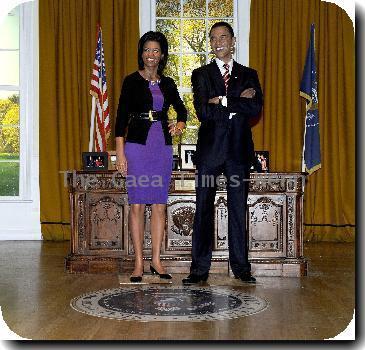US offshore drilling plan to tap huge resources, don’t expect a drop in pump prices soon
By Chris Kahn, APWednesday, March 31, 2010
Offshore drilling could tap large supplies
Opening more of America’s coastlines to oil and natural gas drilling won’t cut energy prices anytime soon. And it won’t greatly reduce the country’s dependence on foreign oil.
But it could bring sizable royalties for a handful of states and soften the blow of future price spikes.
President Barack Obama on Wednesday said he wants to give the petroleum industry access to the southern Atlantic coastline, the eastern Gulf of Mexico and more of Alaska’s coast. He cited the country’s growing thirst for energy, its large dependence on foreign energy sources and the need to create jobs as reasons behind the decision.
Obama also wants to woo Republican support for a climate change bill that would cause financial pain for many producers of fossil fuels.
So, just how would his proposed offshore drilling plan affect U.S. energy supplies and prices? And what about the economy?
—Where will companies be allowed to drill, and exactly how much is down there?
Oil and gas resources would be developed about 50 miles off the Virginia coast and more than 125 miles from Florida’s coast in the eastern Gulf of Mexico. The government also will allow oil exploration in the Arctic Ocean. The President doesn’t support drilling at Bristol Bay in Alaska because of environmental concerns. He said proposed leases in that area would be canceled.
It’s always tough to say exactly how much oil and gas lies under the ocean. But if drillers are able to tap as much as the government estimates in the areas to be opened for exploration, they could pump enough to cover a 15-year supply of oil and a 22-year supply of natural gas for the nation.
In the Gulf, there’s anywhere from 36 billion to 41.5 billion barrels of undiscovered, recoverable oil and 161 trillion to 207 trillion cubic feet of undiscovered natural gas, according to the Minerals Management Service.
There’s another 39 billion to 63 billion barrels of oil and 168 trillion to 294 trillion cubic feet of natural gas in eight planning areas in the Arctic and Atlantic oceans that are under consideration for leases between 2012 and 2017.
—Will this affect gasoline prices?
Very little. Opening previously restricted areas to drilling would cut oil prices by less than 3 cents a gallon by 2030, which would have little effect on gasoline prices, according to Michael A. Levi, an energy expert at the Council on Foreign Relations.
There would be other benefits, however. Both the federal government and some coastal states would receive royalties for the oil produced. Those royalties would help offset the impact of the expected rise in energy costs.
“If oil prices went up, consumers would be spending more, but more money would be flowing in because of all the oil that was sold,” Levi said.
—How much would states benefit from increased offshore drilling?
It depends on the amount of oil produced and the kind of contracts that oil companies are willing to sign. Still, any new drilling would help fill coffers in a number of states.
Since 2007, the federal government shared leasing revenues in the Gulf of Mexico with Louisiana, Texas, Alabama and Mississippi as part of the Gulf of Mexico Energy Security Act. Last year, those revenues amounted to $2.2 million for those states, according to the Minerals Management Service.
Alaska also receives royalties from offshore oil drilling.
MMS spokesman Nicholas Pardi said those states and Florida will likely receive added revenue from new offshore leases. Virginia isn’t part of a revenue-sharing program for the tracts that were opened for exploration in Wednesday’s announcement, he said.
—When will drilling begin, and when will we see oil flowing to U.S. refineries?
Exploratory drilling could begin as early as this summer in the Chukchi and Beaufort seas in the Arctic. That is only for a preliminary study to determine if those areas are suitable for future leases. Elsewhere, the Department of the Interior plans to hold sales for leases in the Gulf of Mexico, off the Virginia coast and in the Cook Inlet in Alaska by 2012.
It will take years for oil companies to find the right pockets of oil and gas, build deepwater platforms and begin pumping crude to onshore refineries.
—Which companies will be most interested in the new areas?
A handful of oil companies have already been looking for oil in the eastern part of the Gulf and Alaska. Following Obama’s announcement, BP, Royal Dutch Shell and ConocoPhillips said they would be interested in moving into those new areas. Exxon Mobil said it is still evaluating the proposal.
Shell, which announced Wednesday it had started producing oil and natural gas from its deepwater Perdido operation south of Houston, will be taking an especially close look at the eastern part of the Gulf of Mexico.
“We’re very, very interested in that area,” said Marvin Odum, who directs all Shell’s exploration and production activities in North and South America.
Shell’s research in other parts of the Gulf “gives us a pretty good idea where to lease,” Odum said on a conference call with reporters.
BP, which already has numerous drilling projects in the Gulf of Mexico, also welcomed Obama’s announcement on Wednesday. But a company spokesman wouldn’t say whether the company planned to bid for any of the new leases.
ConocoPhillips said it is now going to move forward with plans to drill in the Chukchi Sea. The Houston company already has invested $506 million on exploration in the area, and Obama’s announcement gave it the green light to proceed on its existing lease, spokesman Charlie Rowton said.
“We’re planning to drill our first exploratory well in 2012,” Rowton said.
Tags: Alaska, Barack Obama, Commodity Markets, Energy, North America, Oceans, Ownership Changes, United States, Virginia

